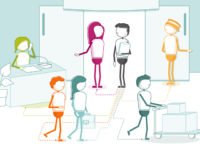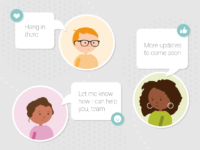Liz Haberberger has worked with individuals and organizations ranging from Fortune 500 companies to smaller, family owned businesses, building long lasting partnerships with clients at global talent company Dale Carnegie. She discusses how the organization transforms individuals to be more confident in their personal and professional lives.
Tell us about your organization.
Dale Carnegie is a training and development company founded in 1912 and operates in every major city in the US and over 80 countries globally. We are the only ISO certified training company and we primarily focus on leadership, management, sales, and communications.
All of our work is rooted in the book How to Win Friends and Influence People. Historically, most of our work has been public programs but in the last decade we’ve seen a big shift into corporate work. Companies want their program to feel like them vs. a third party, so we spend a lot of time working with our customers to understand them and their culture and tailor something to them.
What’s different about being a leader in 2023?
In summer 2020 we saw a lot of demand around leading teams and meetings virtually. Now we’re seeing much les sof a focus on virtual with organizations shifting back to in-office or hybrid. One of our big public clients shared that 90% of their meetings are now in-person.
Tell us about the Leadership training Dale Carnegie delivers to its clients.
For leadership, our work is all rooted in the How to Win Friends and Influence People book distilled down into our Working Together model which has 3 tiers:
- Tier 1 is human connection. Like Google’s Project Artistotle found,
the #1 trait of a high performing team is psychological safety – not about who is on the team but how they work together. Trust, listening, beginning with praise and appreciation, are key here.
- Tier 2 is influence – how do you gain someone’s willing cooperation?
- Tier 3 is change and inspiring others – how do you get someone to want to do something differently? Ask them questions vs. giving orders is a good place to start.
What are you doing to address these challenges?
We provide managers a variety of resources, including even classes designed to help managers to be better leaders, including driving success in a more virtual environment.
We have resources on how to manage remotely, conduct virtual meetings, and even stay connected remotely, for instance through virtual games or happy hours, etc. We’re excited to leverage Bonfyre’s Culture Coach solution to help us bring these recommendations to managers in the flow of work, as well as complementing resources we’ve invested in and are available to our leadership team. We’re going to create more structure around this training and perhaps require managers who have remote team members to attend these training sessions.
One of the questions we are often asked is “how do you actually get people to change or build trust?”
The answer is we don’t.
We focus instead on creating the environment where participants can experience a difference in the interactions. We’ll have them pair up online or in-person, give them different scenarios to talk through together and really listen to each other, and exercises simply to help participants get to know each other better as people. At the end, we ask participants questions like “how often do you listen like that?” and “what would be the impact if you listened like that more?”
These debriefs are the most valuable part of our sessions. This is when links are created between what’s happening in the training room and day-to-day life. We can’t tell someone how to connect it, but if we ask the right questions they can make the link on their own. That’s where the magic happens!
What’s working well with virtual learning? What isn’t?
A lot of the activities we do in-person can be translated to virtual. To me, the more important factors here are if the learning is interactive and experiential or just a lecture. At Dale Carnegie, we believe strong learning and development experiences must be facilitated – whether online or in-person.
What self-guided videos don’t give you is the ability to make that link to your everyday life and work flows.
If you really want someone to make a behavior change it’s gotta be live. Doing this virtually means using the chat boxes, live polls, word clouds, virtual whiteboards, and virtual break rooms.
Remember, in virtual it’s much easier for people to multi-task and tune out – it raises the bar for engagement. Setting really clear expectations upfront also helps – camera on? Be there for every session? Okay to pop off if you have a conflict?
What are the biggest challenges L&D teams are facing generally right now?
Time.
A lot of businesses who have grown immensely and have a lot going on might say learning and leadership development is important but hit pause when they realize the time required to do it well.
Budget is there, but L+D teams have to fight to secure the time and the action/commitment.
Second challenge is “you’re going to do all of that for me?” L+D teams are tasked with figuring out all the needs, create and deliver all the content, and more. They are trying to do onboarding, sales, new employee, first time manager training. They have so much going on but can’t do it all.
What are some of the barriers getting in the way of adoption/engagement with self-guided learning?
Self-guided learning in my experience too often becomes just checking a box – you get the training done, but did you really learn anything? Did you make any connections to your own life and behavior changes you want to make? Self-guided learning is nice because it’s “always on” and easy to access, but it’s also expensive and often underutilized – we frequently see less than 10% of the content even being touched! This happens either because the content isn’t of interest and/or it’s too much work to get to it.
What are some of the most important components of an impactful learning program?
- Awareness: why are people showing up? What should they expect? Where are they now? An assessment is a helpful tool here.
- Experience: is it 4 hours? 2 days? What’s the run of show?
- Sustainment (most important!): Will you actually follow through on what you learned or your takeaways? How do you do sustainment really well? Are we pushing or pulling? How do we make it easy for participants to action and remember the concept.
An analogy I like to use is many companies say we need to focus on the leaders and take them to the gym, but then they go home and eat junk food. Environment is the most important thing.
How do you measure the impact of leadership development after they complete a program?
This is hard. We see 3 levels:
- Level 1 (where most programs are): basic surveys like NPS, voice of the customer, and participant feedback, but that doesn’t really tell you a lot.
- Level 2: Did you learn something? For some skills this is helpful but when it comes to leadership development, it’s one thing to say you learned something and another to actually practice it.
- Level 3: Behavior change that’s sustainable. There are some big gaps here but surveys, accountability calls, and other qualitative feedback can be helpful.
- Level 4: Business outcomes. Increased engagement scores, retention. Hard to pinpoint, did engagement go up because of leadership training?



 6 min
6 min




